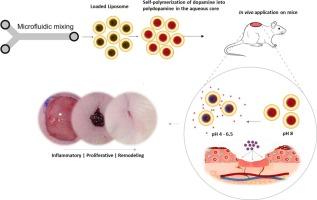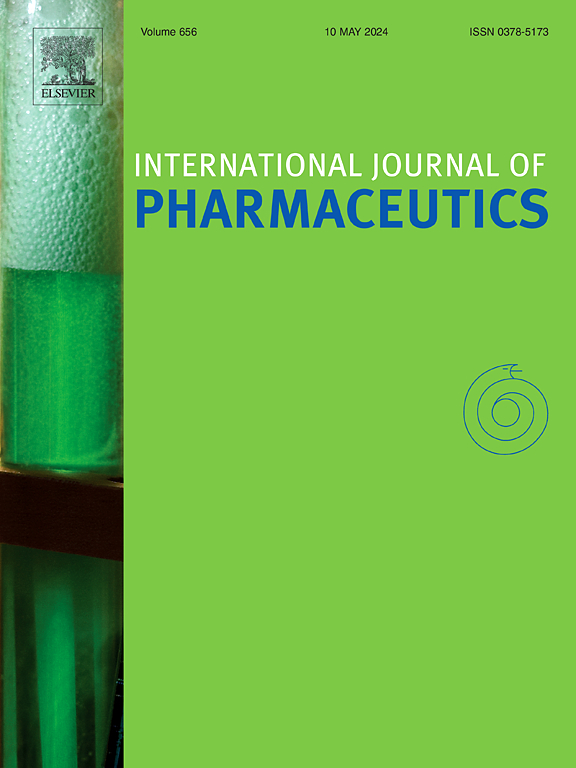新型 pH 值响应混合脂质体的微流控开发:用于增强伤口愈合的体外和体内评估。
IF 5.3
2区 医学
Q1 PHARMACOLOGY & PHARMACY
引用次数: 0
摘要
伤口愈合是一个复杂的生物过程,对组织修复至关重要,尤其是在愈合受损的慢性伤口中。脂质体已成为一种很有前途的载体,可用于输送治疗药物,促进伤口修复。脂质体作为治疗剂的有效载体已得到探索。然而,传统的脂质体制备方法面临着巨大的挑战,尤其是在实现稳定的稳定性以及精确控制药物的封装和释放方面。本研究利用微流体技术率先开发了混合脂质体(HLPs),通过精确管理配方参数提供了更可控的特性,从而应对了这些挑战。值得注意的是,在 HLPs 中形成的聚多巴胺(PDA)聚合物可促进 pH 值响应型药物释放,使其非常适合酸性伤口环境。此外,用叶酸(FA)进行表面修饰可增强细胞与 HLPs 的相互作用。体外和体内研究证明,载入透明质酸(HA)或苯妥英(PHT)的 HLPs 在促进伤口愈合方面具有功效。微流控技术优化了 HLPs 在 90 天内的稳定性,凸显了其作为强效、无抗生素药物输送系统的潜力。总之,这项研究加深了人们对 HLP 微流体优化的理解,提供了最先进的给药系统。微流控靶向 HLPs 的变革潜力有望彻底改变伤口愈合,并为有效的治疗干预带来乐观前景。本文章由计算机程序翻译,如有差异,请以英文原文为准。

Novel microfluidic development of pH-responsive hybrid liposomes: In vitro and in vivo assessment for enhanced wound Healing
Wound healing is a complex biological process crucial for tissue repair, especially in chronic wounds where healing is impaired. Liposomes have emerged as promising vehicles for delivering therapeutics to facilitate wound repair. Liposomes have been explored as effective carriers for therapeutic agents. However, traditional methods of liposome preparation face significant challenges, particularly in achieving consistent stability and precise control over drug encapsulation and release. This study addresses these challenges by pioneering the development of Hybrid Liposomes (HLPs) using microfluidic technology, which provides more controlled characteristics through precisely managed formulation parameters. Notably, the formation of Polydopamine (PDA) polymer within HLPs facilitates pH-responsive drug release, making them well-suited for acidic wound environments. Furthermore, surface modification with Folic Acid (FA) enhances cellular interaction with the HLPs. In vitro and in vivo studies demonstrate the efficacy of HLPs loaded with Hyaluronic Acid (HA) or Phenytoin (PHT) in promoting wound healing. Microfluidics optimizes the stability of HLPs over 90 days, underscoring their potential as a potent, antibiotic-free drug delivery system. In conclusion, this research advances the understanding of microfluidic optimization for HLPs, offering cutting-edge drug delivery systems. The transformative potential of targeted HLPs through microfluidics holds promise for revolutionizing wound healing and inspires optimism for effective therapeutic interventions.
求助全文
通过发布文献求助,成功后即可免费获取论文全文。
去求助
来源期刊
CiteScore
10.70
自引率
8.60%
发文量
951
审稿时长
72 days
期刊介绍:
The International Journal of Pharmaceutics is the third most cited journal in the "Pharmacy & Pharmacology" category out of 366 journals, being the true home for pharmaceutical scientists concerned with the physical, chemical and biological properties of devices and delivery systems for drugs, vaccines and biologicals, including their design, manufacture and evaluation. This includes evaluation of the properties of drugs, excipients such as surfactants and polymers and novel materials. The journal has special sections on pharmaceutical nanotechnology and personalized medicines, and publishes research papers, reviews, commentaries and letters to the editor as well as special issues.

 求助内容:
求助内容: 应助结果提醒方式:
应助结果提醒方式:


